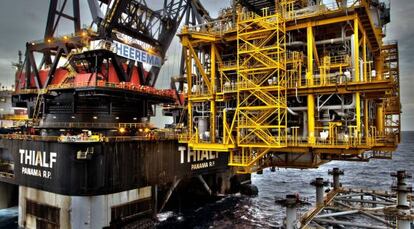Earth tremors in Valencia were caused by undersea gas plant, report confirms
Scientists link offshore Castor storage project to seismic activity recorded in Castellón last year Plant has been shut since quakes, the biggest of which measured 4.2 on the Richter scale


An official report has officially confirmed for the first time that there is a “direct relationship” between the 512 earth tremors recorded in Vinaròs in Castellón province last September and the injection of gas into the nearby Castor offshore storage plant. The National Geographic Institute (IGN), one of two public organizations asked by the government to conduct a detailed study into the causes of the quakes in the Valencia region, concluded: “Everything indicates that the induced seismicity is the result of gas-injection activity.” Local residents felt 15 of the tremors, the biggest of which measured 4.2 on the Richter scale. The government ordered activity at the plant to be stopped on September 26 last year, after the first 200 quakes.
Making use of a depleted oil field 1,700 meters below the sea, the Castor gas-storage plant was being built to hold a quantity of natural gas equivalent to the country’s total consumption over a period of 17 days, in order to cover spikes in consumption levels and interruptions to the supply. Liquid natural gas is supposed to be piped into the empty Vinarós Castellon oil field, via a 13.6-mile-long offshore pipeline. A 19-bank international consortium, five of whose members are Spanish, provided the $1.6 billion in financing for the project.
The IGN report ruled out that the seismic activity had its origins in the Amposta fault line – upon which the plant is built – as was first suspected. “We’re dealing with another fault, one that is not mapped,” it said. “The injection of gas has accelerated a seismotectonic process with a build-up of forces that already existed in the area, but that had not been categorized before,” it added.
Two other big fault lines, plus many other unmapped, smaller ones, also lie nearby. Several geologists consulted by EL PAÍS pointed to these as to blame for the quakes several months ago. One of them, according to the IGN report, has a “direct relation” to the seismic activity.
The IGN experts have not advised the government over what decision to take, despite a request to do so by the Industry Ministry, nor did they predict what might happen if the installation restarted the gas injections.
Local residents felt 15 of the earth tremors last September
United Left congressional deputy Ricardo Sixto had asked to see the contents of the report at the start of the year. But despite being dated December 17, 2013, it was not delivered until April 10 of this year. “The experts say that the studies are still insufficient, which is to say that they don’t know what might happen,” said Sixto. “The platform must remain closed. The closure must cost citizens nothing; we do not have to pay for the wrong decisions that some make,” he added. He said he would seek explanations over the delay in sending the report.
The decision on whether or not to definitively close the plant is one that Industry Minister José Manuel Soria has been putting off for several months. The other report his ministry has commissioned on the issue, from the Geological and Mining Institute of Spain (IGME), has yet to reach Congress. A first version was released in November 2013, which was then revised before the definitive report was delivered in February, according to sources with knowledge of the process. But the ministry has since refused to make it public, despite requests to do so by EL PAÍS.
The plant is designed to cover spikes in consumption levels and interruptions to the supply
But Soria’s decision does not solely relate to energy planning; it is the economic consequences that most worry the government. Escal UGS, the company controlled by Spanish construction giant ACS that manages the plant, has the right to hand back the concession it was awarded for 25 years and receive back the net book value.
According to the Industry Ministry’s calculations, the Castor project has cost €1.702 billion. The government has tried to free itself from that obligation, but last October the Spanish Supreme Court rejected its request to cancel the compensation.
Tu suscripción se está usando en otro dispositivo
¿Quieres añadir otro usuario a tu suscripción?
Si continúas leyendo en este dispositivo, no se podrá leer en el otro.
FlechaTu suscripción se está usando en otro dispositivo y solo puedes acceder a EL PAÍS desde un dispositivo a la vez.
Si quieres compartir tu cuenta, cambia tu suscripción a la modalidad Premium, así podrás añadir otro usuario. Cada uno accederá con su propia cuenta de email, lo que os permitirá personalizar vuestra experiencia en EL PAÍS.
¿Tienes una suscripción de empresa? Accede aquí para contratar más cuentas.
En el caso de no saber quién está usando tu cuenta, te recomendamos cambiar tu contraseña aquí.
Si decides continuar compartiendo tu cuenta, este mensaje se mostrará en tu dispositivo y en el de la otra persona que está usando tu cuenta de forma indefinida, afectando a tu experiencia de lectura. Puedes consultar aquí los términos y condiciones de la suscripción digital.
Últimas noticias
From digital curfews to blocking apps: How technology experts protect their children online
Why the price of coffee has skyrocketed: from Brazilian plantations to specialty coffee houses
Confined to a Cuban hospital: When electricity is a matter of life or death
The complicated life of Francesca Albanese: A rising figure in Italy but barred from every bank by Trump’s sanctions
Most viewed
- Why we lost the habit of sleeping in two segments and how that changed our sense of time
- Pablo Escobar’s hippos: A serious environmental problem, 40 years on
- Trump’s obsession with putting his name on everything is unprecedented in the United States
- The Florida Keys tourist paradise is besieged by immigration agents: ‘We’ve never seen anything like this’
- Charles Dubouloz, mountaineering star, retires at 36 with a farewell tour inspired by Walter Bonatti








































